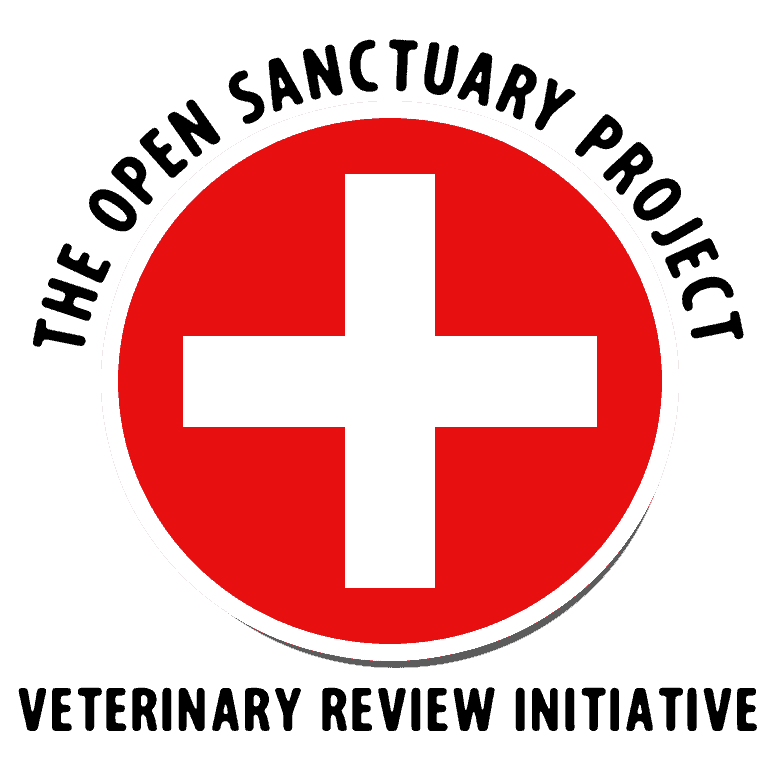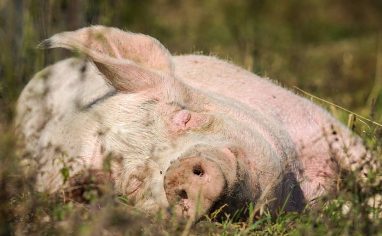

Veterinary Review Initiative
This resource has been reviewed for accuracy and clarity by a qualified Doctor of Veterinary Medicine with farmed animal sanctuaryAn animal sanctuary that primarily cares for rescued animals that were farmed by humans. experience as of July 2021.
Check out more information on our Veterinary Review Initiative here!
Depending on the species you care for at your farmed animalA species or specific breed of animal that is raised by humans for the use of their bodies or what comes from their bodies. sanctuary, you may have heard about Johne’s disease (pronounced “yo-nees”) and wonder how you can keep your residents safe. It can be difficult navigating all of the available information and figuring out how it pertains to a sanctuary setting. We always recommend working with a trusted veterinarian when creating care protocols for your sanctuary, but have compiled the following information on Johne’s disease to give you a foundation for having that conversation so that you can make informed decisions for your residents. While this resource is designed to discuss Johne’s disease in a variety of species, you will find that the majority of the information pertains to cowsWhile "cows" can be defined to refer exclusively to female cattle, at The Open Sanctuary Project we refer to domesticated cattle of all ages and sexes as "cows.", simply because most studies have focused on the impact of Johne’s disease on the dairy industry.
What Is Johne’s Disease?
Also known as paratuberculosis, Johne’s disease (JD) is a contagious chronic inflammatory bowel disease that primarily affects the small intestine and interferes with nutrient absorption. Clinical stages of the disease result in chronic weight loss (or wasting), despite a healthy appetite. Johne’s disease is caused by a type of bacteria called Mycobacterium avium subspecies paratuberculosis (MAP).
Which Species Can Be Infected With MAP?
It is believed that all species of ruminants (such as cows, sheep, goats, deer, and elk) and camelids (such as llamas and alpacas) are susceptible to this infection. While domesticatedAdapted over time (as by selective breeding) from a wild or natural state to life in close association with and to the benefit of humans ruminant and camelid species are primarily affected, there is evidence that some other species can act as reservoirs for MAP. For instance, in Scotland, Johne’s disease is endemic in wild European rabbitsUnless explicitly mentioned, we are referring to domesticated rabbit breeds, not wild rabbits, who may have unique needs not covered by this resource., who likely became infected due to sharing pastures with infected domesticated ruminant species.
While pigs, horses, and dogs have shown some degree of susceptibility to MAP, infections in these species are currently rare. Researchers are also exploring the link between MAP and Crohn’s disease in humans.
Can The Disease Be Transmitted Between Species?
The short answer to this is yes, Johne’s disease can be transmitted between different species. However, there are different strains of MAP, and the likelihood of cross-species transmission appears to vary based on the strain. Currently, the two main strains are the cattle strain (or C-strain) and the sheep strain (or S-strain), but bison and goat strains have also been identified. The S-strain is mostly seen in sheep in Australia, and while it can infect other species, it appears to be less likely to do so than the C-strain, but whether or not this is because of differences in susceptibility or differences in exposure remains unclear. The C-strain is considered more “versatile” than the S-strain; in addition to infecting cows, it can also infect other ruminants (and is common in sheep in the US) and also affects camelids. Though both wild and domesticated species can become infected with MAP, according to the Committee on the Diagnosis and Control of Johne’s Disease, evidence of spread from wild species to domesticated species has not been documented. However, outbreaks in wild populations have been attributed to spread from domesticated animals.
How Is Johne’s Disease Spread?
The primary mode of transmission is the fecal-oral route. Infected individuals, including some who are not yet showing signs of disease, shed MAP in their feces. MAP cannot multiply outside of an animal’s body, but the organism can survive for up to a year in many environments.
Young individuals of all ruminant and camelid species are believed to be most susceptible to the infection. In cows, studies suggest that resistance to MAP infections increases with age- calves under 6 months of age are considered most vulnerable, and studies suggest that a one-year-old has the same level of resistance as an adult. Young individuals may ingest infectious feces by eating or drinking contaminated food or water, grooming or licking herdmates or objects contaminated with infected feces, or, if they are nursing, their mother’s teat may be contaminated with feces, resulting in exposure while nursing. Additionally, if their mother has Johne’s disease, it’s possible that she could spread the disease in her milk and colostrum. Spread via milk and colostrum has mostly been studied in cows- studies have found MAP present in the milk and colostrum of both cows showing clinical signs of disease, as well as those who are asymptomatic. In utero infections are also possible, and though the prevalence of this type of transmission is currently unclear, studies focused on cows suggest this is more common in cows with advanced disease.
How Is Johne’s Disease Diagnosed?
Diagnosing Johne’s disease can be difficult, especially when individuals are not showing clinical signs of the disease. Apparently healthy individuals may show exposure to Johne’s through the presence of antibodies in their blood. It can take up to one year after exposure to MAP for antibodies to develop. This delay in antibody production can make diagnosis of exposure through screening antibody detection tests (ELISA and AGID) difficult. In other instances, an individual may have clinical signs of Johne’s disease, but due to their immunocompromised state, antibody titers may be below the level of diagnostic test detection. For this reason, in clinical cases it is recommended to pair antibody detection tests with test methods that identify the presence of the MAP organism in feces (fecal culture or PCR). We recommend having a conversation with your veterinarian about testing options and protocols for the species in your care. They may recommend certain tests for screening purposes and others when Johne’s disease is suspected. In some cases, using a combination of tests may be recommended to confirm a Johne’s diagnosis.
Be sure to check with your diagnostic lab to see which tests they offer for the species in your care, as this will vary from lab to lab, and some tests may not be recommended for certain species. Common diagnostic tests are:
Fecal Culture
This testing method looks for viable MAP organisms in a fecal sample and can assess the risk of transmission by evaluating the amount of MAP being shed. Unfortunately, because MAP is a slow-growing organism, these results take longer than other tests- depending on the method used, it can take as long as 16 weeks to get results. The turnaround time for MAP culture is often shorter when a higher load of bacteria are being shed.
PCR
This test looks for MAP DNA rather than viable organisms in a fecal sample. Unfortunately, Johne’s PCR tests are not validated in all ruminant and camelid species, so may not be an option, or may need to be done in conjunction with a fecal culture. The main advantage of PCR testing is that it does not take as long as a fecal culture to get results- generally, results take less than a week (though you should check with your lab regarding their expected turnaround time). Depending on the method used, the sensitivity (ability to accurately detect a positive result) and specificity (ability to accurately detect a negative result) varies, but in the US there is a commercially available direct-time PCR method approved by the USDAThe United States Department of Agriculture, a government department that oversees agriculture and farmed animals. that is comparable to culture results in terms of sensitivity and specificity. Though not all PCR methods can evaluate the risk of transmission by quantifying the amount of MAP being shed, real-time PCR methods can estimate the degree of fecal shedding.
Blood Serum Antibody Tests
ELISA and AGID tests detect antibodies in blood serum (or milk). Your veterinarian can recommend which test is best given the specific situation and species being tested. Typically, the ELISA test is recommended over the AGID for screening purposes in sheep, goats, and cows, but is not validated in camelid species. We will discuss screening protocols in more detail below. Antibody tests are not recommended for individuals under six months of age due to the risk of maternal antibody interference.
For more information regarding available diagnostics and species-specific testing recommendations, check out the American College of Veterinary Internal Medicine (ACVIM) Consensus Statement on Johne’s disease (starting on page 1240) and Cornell University Animal Health Diagnostic Center’s Johne’s Disease Program Sampling and Testing Options.
What Happens When An Individual Becomes Infected?
Following ingestion of MAP, one of two things will happen, and the outcome depends on many factors. In addition to age-related resistance, genetic factors may also contribute to how susceptible an individual is to MAP. The amount of MAP an individual is exposed to will also play a role in whether or not they will become infected, with adults believed to be able to tolerate higher levels of exposure than younger individuals before becoming infected. Exposure rate is also believed to play a role in how quickly the disease progresses.
Following exposure, one possible outcome is that the bacteria will pass through the individual without causing infection. If this is the case, the individual will not develop clinical signs of disease but could briefly pass MAP in their feces and, therefore, initially test positive on a fecal culture or PCR (but would test negative on a blood serum or follow-up fecal tests- more on this in “What If One Of My Residents Test Positive?”). The second outcome is that the individual will develop a chronic, persistent infection and may eventually develop clinical signs of Johne’s disease. Infected individuals can remain asymptomatic for years, but may be intermittently shedding MAP, contributing to spread to other residents.
Johne’s Disease In Cows
The disease progression in cows is generally broken down into 4 stages:
Stage 1- Silent Infection
In this stage, the individual is infected, but does not show any signs of disease and is not shedding MAP in their feces. Detection at this stage is not possible with the diagnostic tools currently available.
Stage 2- Subclinical Disease
In this stage, the individual still is not showing outward signs of disease, but may be shedding (and therefore, potentially spreading) MAP intermittently. Diagnostic testing will not reliably detect all positive individuals in stage 2. Therefore, a negative result cannot definitely rule out the disease. Some individuals slowly progress to stage 3, but because of their shortened lives in industrial settings (where much of the current information comes from), it is difficult to say approximately what percentage typically progress beyond this stage. In a sanctuary setting, where residents are able to live into old age, it can be assumed that the chance of a Johne’s- positive individual eventually developing clinical disease is much higher than in an industry setting.
Stage 3- Clinical Disease
Typically, clinical signs of Johne’s disease do not present until several years following infection. While the majority of MAP infections occur when individuals are very young, in general, most infected cows will not show signs of disease until they are at least 2 years old, and some sources suggest it can take as long as 6-10 years before a cowWhile "cow" can be defined to refer exclusively to female cattle, at The Open Sanctuary Project we refer to domesticated cattle of all ages and sexes as "cows." shows clinical signs. Evidence suggests that the onset of clinical signs may be brought about by stressors such as transport, malnutrition, parasitism, or giving birth. Initial signs of disease tend to be subtle and similar to signs of other diseases, so misdiagnosis is fairly common unless there is known history of exposure. Initial signs of Johne’s disease include weight loss despite a normal appetite, a rough coat, and, if lactating, a drop in milk production. Over the span of a few weeks, the individual will develop intermittent diarrhea that will become more frequent over time. Individuals showing clinical signs of disease typically shed much larger amounts of MAP than those who are subclinical, and a fecal culture or PCR will be able to detect this stage of infection in most cases. Blood testing may also detect the disease, but in general, fecal culture and PCR are the most accurate diagnostic tests for cows showing signs of clinical disease. There have been rare cases where individuals in stage 3 have reverted back to stage 2, but this is considered unusual.
Stage 4- Advanced Clinical Disease
Individuals may progress from stage 3 to stage 4 in just a few weeks. As the disease progresses, so too will their lethargy, weakness, and emaciation. Bottle jaw (fluid build-up under the jaw due to low serum total protein), severe emaciation, and profuse liquid diarrhea are classic signs of advanced Johne’s disease. Stage 4 is considered end-stage disease, with dehydration and emaciation becoming so severe that they ultimately result in death. Most diagnostic tests will be able to accurately detect the disease in this stage; however, if an individual with advanced disease becomes immunocompromised, they may not produce antibodies, and, therefore, will not test positive on blood tests.
Johne’s Disease In Sheep And Goats
Compared to the information about cows, there is much less information about Johne’s disease that focuses specifically on sheep, and there is even less that focuses on goats. However, for the most part, it seems that in sheep and goats, the disease progresses similarly to cows with a few exceptions. First, the diarrhea that is so often seen in stage 3 and 4 in cows is seen much less often in sheep and goats, with only about 20% of sheep and goats developing diarrhea. Second, it is believed that the disease may progress more rapidly in sheep and goats as compared to cows, and while many sources suggest that clinical signs typically do not present before 2 years of age, others suggest that clinical signs in younger individuals are seen more commonly in sheep and goats than in cows.
Clinical signs in sheep and goats typically include progressive weight loss despite a normal appetite, and individuals may develop bottle jaw. However, much like in cows, because these can be signs of many other health challenges, including parasitism, diagnosis based on clinical signs alone is not reliable. In woolen individuals, poor wool quality and wool loss may also be seen.
Johne’s Disease In Llamas And Alpacas
While camelids can be affected by Johne’s disease, there is currently much less information focused on Johne’s disease in camelids as compared to cows or even sheep. Based on the available information, it seems that the clinical signs seen in sheep and goats are also seen in camelids, with emaciation despite a healthy appetite being the most common sign. Camelids may develop diarrhea, but this is often seen only in the end stages of the disease. One major difference between ruminants and camelids seems to be the age at which individuals show clinical signs of disease- confirmed cases of Johne’s disease in camelids suggest that they develop clinical signs of disease at a much earlier age than other species.
Is There Any Treatment For Johne’s Disease?
There is currently no cure for Johne’s disease, and treatment is not often attempted. There are multiple challenges regarding treatment of Johne’s disease, one of which being that in many species found at a farmed animal sanctuary, there are restrictions on what drugs can legally be used (and which conditions they can be used to treat) due to their designation as “food animals” by the USDA (or similar authority). Another challenge is that most treatments reduce clinical signs of disease but do not eliminate shedding (though some treatments may reduce shedding). This means an infected individual will continue to pose a risk to other residents, despite treatment. Because treatment is not often attempted and not all of the possible treatments are approved for use in farmed animal species, there is limited information available regarding the efficacy of various treatment protocols. For more information on potential treatment options, check out the ACVIM Consensus Statement on Johne’s disease (starting on page 1245).
While there are vaccines available in some countries, according to the World Organisation For Animal Health, “they are used only in very well defined situations and under strict regulatory control.” Vaccination in a sanctuary setting is likely not possible or advisable, and would not be a replacement for other preventative measures, such as those described below.
What Can I Do To Keep My Residents Safe?
Johne’s disease is especially challenging because healthy-looking individuals can be unknowingly infected and shedding MAP. By the time an individual is showing clinical signs of Johne’s disease, they have likely been shedding MAP for some time, putting other residents at risk. Additionally, even with the most robust screening practices, the current limitations of diagnostic testing makes it impossible to completely eliminate all possible risks of introducing Johne’s disease to your residents so long as you are welcoming new individuals to your sanctuary.
Because of these challenges, one common (industry) recommendation is to avoid introducing Johne’s disease to an established herd all together by maintaining a “closed herd” (not bringing in new residents) or by only taking in individuals from Johne’s-free herds. Because sanctuaries rarely know the health history of new residents, there is simply no way to ensure that you will never welcome an individual to your sanctuary who has been exposed to MAP. Short of deciding you will no longer accept new residents, what can you do to protect the individuals in your care from this very serious disease? Again, we always recommend having a conversation with a trusted veterinarian who knows the specifics of both your current set-up and population, as well as the specifics of your area, but here are a few general suggestions for protocols that can help keep your residents safe and mitigate the risk of exposing residents to MAP:
Implement Incoming Johne’s Testing Protocols
While no Johne’s diagnostic test is perfect, and there are challenges detecting early stages of disease, in order to lessen the risk of introducing MAP to individuals who have not previously been exposed, we recommend all incoming ruminants and camelids over six months old be tested for Johne’s disease prior to being introduced to other residents and prior to discontinuing quarantineThe policy or space in which an individual is separately housed away from others as a preventative measure to protect other residents from potentially contagious health conditions, such as in the case of new residents or residents who may have been exposed to certain diseases.. Testing individuals under six months of age is difficult because antibody tests could result in a false positive due to maternal antibodies, and fecal tests likely will not be useful in non-clinical individuals because shedding at this age is uncommon. Even when they are over six months of age, testing can be challenging, so be sure to talk to your veterinarian about their specific recommendations for testing younger individuals.
Your veterinarian can recommend specific tests based on the individual’s species and other factors, but in order to mitigate the risk of not detecting a Johne’s- positive individual, your veterinarian may recommend using both a fecal test (culture and/ or PCR, depending on the species) and also a blood test to check for antibodies (ELISA or AGID, depending on the species).
Because of the possibility that a newly rescued individual could have been very recently infected, it’s a good idea to retest all incoming residents (who are over six months old) prior to discontinuing quarantine and introducing them to other residents. Based on our conversation with an experienced veterinarian, we suggest waiting at least one month prior to retesting, though your veterinarian may recommend waiting longer than that if you have the quarantine capacity to do so.
Establish Routine Screening Protocols
Because there will always be a chance that a healthy-looking arrival tests negative for MAP despite being infected, talk to your veterinarian about routinely testing your ruminant and camelid residents for Johne’s disease. This practice will make it more likely that you are able to identify a positive individual before they are showing clinical signs of disease (and likely shedding larger numbers of the bacteria, increasing the risk of disease spread). As stated above, due to the limitations of current diagnostic testing, there will always be a chance of missing Johne’s- positive individuals who are in the early stages of disease. Therefore, it’s important to establish protocols that help mitigate that risk as much as possible, and work to identify these individuals as early as possible. Testing your residents every 6-12 months can reduce the risk of an individual unknowingly spreading the disease for years before showing clinical signs. Even though there is no proven treatment for the disease, identifying positive individuals will allow you to make informed decisions to prevent further spread of disease and protect your most vulnerable residents (more on this below).
Your veterinarian can recommend the best screening tests for your residents. In order to reduce costs, they may recommend pooling samples for screening purposes (combining samples from multiple individuals into one sample to be tested). A positive result would then require individual testing of all residents included in that pooled sample to identify the positive individual(s). Because pooled testing strategies can vary by diagnostic laboratory and species, it’s important to discuss routine screening diagnostics strategy with your veterinarian. If financial constraints make routine testing of all ruminant and camelid residents impossible, see if your veterinarian recommends specific species or populations to be regularly tested based on the specifics of your sanctuary and set-up.
Cleaning Practices
Good sanitation is important for a variety of reasons, but can also play an important role in preventing exposure to MAP, should one of your residents be shedding the bacteria unknowingly. Ingesting feces containing MAP is the most common way Johne’s disease spreads. By keeping living spaces clean and regularly removing feces, you will limit potential exposure. Keep in mind that if you dispose of bedding by spreading it onto pastures, and one of your residents is unknowingly infected and shedding MAP, this practice could result in contamination of pastures and potential disease spread.
Think About Milk And Colostrum Sources
In most cases, MAP is first introduced to a group through an infected individual who then spreads the bacteria in their feces. However, because of the risk of disease spread through colostrum and milk, it’s important to ensure you are offering your residents the safest sources possible. The purpose of the following information is simply to discuss which colostrum and milk options carry the lowest risk of containing MAP and not the possible ethical concerns of particular sources. Ultimately, how you decide to source a neonate’s necessary milk or colostrum will depend on your Philosophy Of Care, but it is important to understand the potential risks associated with these sources.
Newborn residents who do not have their mother and are less than 24 hours old should be fed colostrum. There are commercial colostrum replacers available (not to be confused with a colostrum supplement). The alternative, though one that may not be available to everyone and one that might not match one’s Philosophy Of Care, is to use raw colostrum from a mother who has just recently given birth. Ethics aside, unless the colostrum is coming from a certified Johne’s-free facility (the US and other countries have certification programs to designate farmsFor-profit organizations focused on the production and sale of plant and/or animal products. as Johne’s-free), there is a risk that the colostrum could contain MAP. Using colostrum replacer is a safer option and one sometimes employed by commercial farms to prevent the risk of disease spread.
When feeding milk to young residents, sanctuaries typically choose between a commercial milk replacer or store-bought milk. Though a recent study suggests the possibility of MAP being present in commercial milk replacers, the ACVIM Consensus Statement on Johne’s disease states that uncontaminated milk replacer is MAP-free (the samples used in the study linked above were collected from farms rather than straight from the manufacturer, and the authors recognize that the risk of contamination at the farms could not be completely ruled out). Even if the source of MAP in commercial milk replacers cannot be explained by contamination, whether or not the levels of MAP found would be enough to result in disease is unknown, and currently, commercial milk replacer is widely recognized as a safe option.
If opting for store-bought milk products, your safest bet will be those that are pasteurized rather than raw. While pasteurization does not sterilize milk, studies show that pasteurization does reduce the risk of disease spread when compared to non-pasteurized milk.
Practice Good Biosecurity
Be sure to consider other ways MAP could be brought onto your property. Vehicles and equipment can act as fomitesObjects or materials that may become contaminated with an infectious agent and contribute to disease spread, bringing infectious feces to your sanctuary. Depending on who and what comes into your residents’ living spaces, you may want to enact certain protocols to reduce any risk of this source of contamination.
What If One Of My Residents Tests Positive?
First, if one of your residents tests positive, be sure to talk to your veterinarian about whether or not they should be retested based on the specifics of the situation. Remember, individuals under six months of age can test positive on an antibody test due to maternal antibody interference, and in a recently exposed individual, “pass-through” of the bacteria is possible and could result in a transient positive fecal test (and negative antibody test). It’s important to work with your veterinarian to determine the best course of action for follow-up testing. While “pass through” without infection is possible, it’s important to recognize that these individuals have been exposed to MAP- remember it can take up to a year before an infected individual develops antibodies, so a negative blood test now does not mean they will not go on to develop antibodies.
Our focus in this section will be on ways to reduce the risk of disease spread, not how to specifically care for an individual who has tested positive. An individual who tests positive for MAP has the potential to develop clinical disease, but they could remain healthy for years before doing so. While “culling” Johne’s- positive individuals is often included in industry-based recommendations, at a sanctuary, all euthanaisa decisions should be based on an individual’s quality of life. However, in addition to caring for the individual, it is also important to consider the potential risk posed to other residents so that you can make informed decisions about how to prevent disease spread.
Johne’s Is A Notifiable Disease In Some Regions
Notifiable (reportable) diseases vary from region to region. In the US, Johne’s disease is reportable in some states, but not all. Your veterinarian will be able to tell you whether or not Johne’s is reportable in your region.
We strongly recommend working with an experienced veterinarian who can assess your set-up, evaluate your current practices, and make recommendations tailored to your specific situation. They can also help identify possible sources of disease spread that may not be addressed below.
Protect Vulnerable Residents
The ACVIM Consensus Statement on Johne’s disease provides evidence-based recommendations for “managing” infected herds, and while some of the recommendations do not apply, or are not appropriate, in a sanctuary setting, some of their guidance regarding preventing new infections can be helpful for sanctuaries to review when establishing their own protocols. Because young individuals are believed to be most at risk of becoming infected, at a minimum, sanctuaries should identify ways to protect them from exposure to MAP. The World Health Organisation For Animal Health (OIE) recommends preventing calves, goat kids, and lambs (we’d say criasYoung llamas or alpacas, too) from coming into contact with possible sources of infection for at least their first year of life. Cornell University’s Animal Health Diagnostic Center offers a similar recommendation specifically for calves, but says two years is preferable. While these recommendations may reduce the risk of vulnerable residents becoming infected and eventually developing clinical disease due to assumed age-related resistance, it’s important to note that individuals never become completely resistant to MAP. We prefer to err on the side of caution- therefore, even though studies suggest that a one-year-old has the same level of resistance as an adult, and OIE recommends protecting individuals from exposure until they are at least one year of age, we suggest following Cornell’s more conservative recommendation of protecting residents until they are at least two years of age. Going forward, we will refer to neonates and individuals under two years of age as “vulnerable residents”, but we are not implying that there is no risk for individuals over this age.
Because the fecal-oral route is a major cause of disease spread, it’s important to eliminate or seriously reduce the risk of vulnerable residents coming into contact with, and possibly ingesting, MAP-infected feces. To do this, consider the following:
Living Arrangements
Not only should vulnerable residents be housed separately from Johne’s- positive residents, they should also be housed separately from anyone who has potentially been exposed, as they could be a silent carrier. In addition to keeping vulnerable individuals separate from Johne’s- positive individuals (and their herd or flockmates), it’s important to have enough separation between these groups so that fecal contamination of vulnerable residents’ living spaces is not possible and that prevents physical contact between these groups. The safest option would be to house vulnerable residents in separate structures from those who are positive, which will help prevent fecal contamination. This will also address any potential risk associated with bioaerosol transmission- more research is needed to confirm whether there is a risk of bioaerosol transmission of MAP in ruminant and camelid species.
In outdoor areas, these groups should not share a fence line. Also keep in mind that MAP can survive in the environment for some time, so it’s not enough to simply prevent vulnerable residents from grazing on pastures recently grazed by a Johne’s- positive individual. It’s better to have designated pastures that are considered contaminated and those that are considered safe.
Food And Water Sources
Make sure that any food and water sources are protected from fecal contamination. If bowls, troughs, or other items are used for vulnerable residents, they should be designated for use only with these individuals to prevent the risk of contamination. If these items leave their living spaceThe indoor or outdoor area where an animal resident lives, eats, and rests., be sure to keep them away from individuals, areas, or objects that could result in contamination with MAP.
Establish Strict Biosecurity Measures
BiosecurityMerck Veterinary Manual defines biosecurity as ”the implementation of measures that reduce the risk of the introduction and spread of disease agents [pathogens].” is always important but to prevent MAP spread via fomites, be sure to enact specific practices that will prevent a person or object from introducing MAP to vulnerable residents. Tools and equipment should not be used to clean or remove feces in a Johne’s- positive area and then in a vulnerable resident’s area. Ideally, you should have designated tools for each group. This can be more difficult when it comes to equipment, which may need to be shared. In order to prevent spreading MAP, avoid driving tractors or other equipment or vehicles into Johne’s positive areas whenever possible. Protective footwear should be worn in contaminated spaces to prevent tracking MAP into non-infected areas. Additionally, feces and bedding from a Johne’s positive area should be disposed of in a way that will not contaminate other areas.
Protecting Mature Residents
If you choose to house a Johne’s- positive individual with adults who are negative, it’s important to remember that while the risk of adult residents becoming infected appears to be significantly less than a neonate, this risk is not zero- heavily contaminated environments could result in disease transmission. Therefore, it is important to implement robust sanitation protocols and consider the degree to which a positive resident is shedding the bacteria.
Talk with your veterinarian about each specific situation, including the potential risk posed to herd and flockmates, as well as ways to mitigate those risks as much as possible. This may include opting not to introduce any new residents to this group, regardless of their age, in order to prevent future infections, and may also include regular testing to assess how much bacteria a positive individual is shedding and adjusting your protocols if a low shedder becomes a moderate or high shedder. In cases where multiple individuals have Johne’s disease, housing positive and negative residents separately is a good idea when possible. While not always feasible given a sanctuary’s set-up, further separation of positive individuals based on their degree of shedding may be advised (i.e low shedders in one group and high shedders in another group). When separating residents based on shedding or infection status, be sure to enact appropriate biosecurity measures to complement this housing strategy.
Finding ways to prevent food and water from becoming contaminated with MAP will also help reduce disease spread, though this is difficult when individuals are grazing on pasture. Feeding hay up out of feeders that keep hay contained and less likely to be defecated on will help reduce contamination. If your residents’ living spaces contain ponds or other water features, talk to your veterinarian about the risks these pose, as MAP can live in water sources for some time.
Johne’s is a challenging and frustrating disease, especially in a sanctuary setting where individuals often arrive with unknown backgrounds and can come from situations where the risk of MAP exposure could be high. It’s important to understand this disease and work with a trusted veterinarian to establish protocols and procedures that will mitigate the risk of introducing MAP to your residents, while recognizing that completely eliminating all risk is not possible outside of a “closed herd” setting. If you find yourself in a situation where you are caring for a resident (or multiple residents) with Johne’s disease, be sure to create a plan to compassionately care for these residents while also evaluating the risk posed to other residents and finding ways to lower that risk as much as possible.
Summary Of Key Points
Disease Overview-
- Johne’s disease most commonly affects domesticated ruminant and camelid species and is caused by Mycobacterium avium subspecies paratuberculosis (MAP).
- The most common mode of transmission is the fecal-oral route, though MAP can also be spread via milk and colostrum.
- Cross-species transmission is possible.
- Younger individuals, especially those under 6 months of age, are most vulnerable to becoming infected. Adults are more resistant to the infection, but exposure to high levels of MAP could result in infection.
- Infected individuals often remain asymptomatic for years, though depending on the species, clinical signs of disease may develop in younger individuals. In the sub-clinical stage of infection, individuals can intermittently shed the bacteria in their feces, resulting in possible disease spread.
- Clinical signs of Johne’s disease are emaciation despite a healthy appetite and, often, bottle jaw. Profuse, watery diarrhea is common in cows, but less so in other species. Individuals with clinical disease shed large quantities of MAP in their feces.
- Currently, there is no cure for Johne’s disease, and treatment is often not attempted.
Diagnosing Johne’s Disease-
- Diagnostic tools include fecal culture and PCR, which look for MAP organisms or its DNA, and ELISA and AGID tests run on blood (or milk), which look for antibodies indicative of exposure to MAP.
- Be sure to work with your veterinarian to determine the best testing options based on the species of the individual, the situation, and the capabilities of the laboratory.
- It can be difficult to diagnose Johne’s disease in the early stages of disease when individuals may not be producing antibodies or shedding large quantities of MAP- a negative result cannot definitively rule out the possibility of disease.
- There are additional challenges associated with testing younger individuals. Testing individuals under 6 months of age is especially challenging since antibody tests are not reliable and they likely will not yet be shedding the bacteria in their feces.
Preventive Measures-
- Incoming ruminant and camelid residents over 6 months of age should be tested upon arrival and retested prior to discontinuing quarantine and introducing them to other residents, though negative tests cannot completely rule out the possibility that they are infected.
- Routine screening of established residents can help identify positive individuals before they are showing signs of clinical disease and shedding larger quantities of MAP.
- Enact robust cleaning procedures and practice good biosecurity.
In The Event Of A Positive Diagnosis:
- Work with your veterinarian to determine if repeat testing is advised based on the individual’s age and the specifics of the situation. If not already done, it is helpful to use a diagnostic test that can quantify the degree to which an individual is shedding, as this correlates to the risk of disease spread.
- There is no proven treatment for Johne’s disease, but positive residents who are not showing clinical signs can remain healthy for years. Always consider an individual’s quality of life before considering euthanasiaThe act of ending someone’s life to spare them from suffering or a significantly reduced quality of life that cannot be managed..
- Work with an experienced veterinarian who can evaluate your set-up and current practices and make recommendations to reduce the risk of disease spread based on your specific situation.
- At a minimum, vulnerable residents should be protected from exposure to MAP until they are at least one year old, though two years is preferable.
SOURCES:
Viable Mycobacterium Avium ssp. Paratuberculosis Isolated From Calf Milk Replacer
Paratuberculosis (Johne’s Disease) In Cattle And Other Susceptible Species | ACVIM Consensus Statement (Non-Compassionate Source)
Diagnosis and Control of Johne’s Disease | National Research Council (Non-Compassionate Source)
Clinical Description And Epidemiology Of Johne’s Disease In Cattle | Cornell University College Of Veterinary Medicine (Non-Compassionate Source)
Principles of Johne’s Prevention and Control | Cornell University College Of Veterinary Medicine (Non-Compassionate Source)
Paratuberculosis In Cattle | Marie-Eve Fecteau DVMDoctor of Veterinary Medicine, an academic degree awarded to veterinarians in many countries. (Non-Compassionate Source)
Overview of Paratuberculosis | Merck Veterinary Manual (Non-Compassionate Source)
Johne’s Information Center (Non-Compassionate Source)
Paratuberculosis | World Organisation For Animal Health (Non-Compassionate Source)
Johne’s Disease | USDA Animal And Plant Health Inspection Service (Non-Compassionate Source)
Large Animal Internal Medicine’ 6th Edition | Smith, Van Metre, Pusterla (Non-Compassionate Source)
Cattle Medicine | Phillip Scott, Colin D. Penny, and Alastair Macrae(Non-Compassionate Source)
Sheep And Goat Medicine, Second Edition(Non-Compassionate Source)
Medicine and Surgery of Camelids, Third Edition (Non-Compassionate Source)
Efficacy Of Feeding Plasma-Derived Commercial Colostrum Replacer For The Prevention Of Transmission Of Mycobacterium Avium subsp Paratuberculosis In Holstein Calves (Non-Compassionate Source)
Non-Compassionate Source?
If a source includes the (Non-Compassionate Source) tag, it means that we do not endorse that particular source’s views about animals, even if some of their insights are valuable from a care perspective. See a more detailed explanation here.








